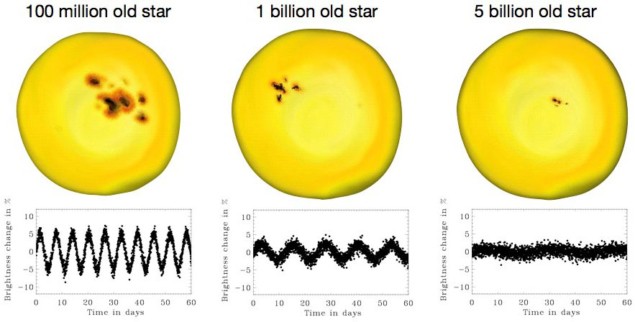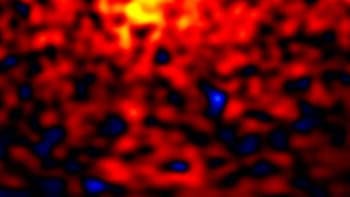
Like some people, stars can be secretive about their age. But now, a team of astronomers has taken an important first step towards developing a new method to determine the age of a star – by measuring its rotation. “A star’s rotation slows down steadily with time, like a top spinning on a table, and can be used as a clock to determine its age,” says astronomer Søren Meibom of the Harvard-Smithsonian Center for Astrophysics. Meibom presented his findings at the 218th meeting of the American Astronomical Society, currently being held in Boston, Massachusetts.
Tell-tale spots
Being able to accurately determine the age of a star is essential in astronomy. It is particularly relevant for stars orbited by extrasolar planets. Meibom and his colleagues are working on a way to deduce the age of a star using information about its rotation, or “spin”, by establishing a correlation between three parameters – the spin period, age and mass of the star. “Ultimately, we need to know the ages of the stars and their planets to assess whether alien life might have evolved on these distant worlds,” says Meibom. “The older the planet, the more time life has had to get started. Since stars and planets form together at the same time, if we know a star’s age, we know the age of its planets too.”
The ages of stars that lie within star clusters are easy to determine, as most of the stars are formed at the same time. Astronomers plot the colours and magnitude of the stars and the pattern they see can be used to tell the cluster’s age. But most stars known to have planets are not part of a cluster, just like our own Sun, and determining their age is much more difficult.
Using NASA’s Kepler space telescope as part of the “Kepler Cluster Study”, Meibom and his collaborators measured the rotation rates for stars in a one billion year old cluster called NGC 6811. The rotation is detected by looking for tiny changes in the brightness of the star caused by “spots” on its surface rotating in and out Kepler’s sight. Kepler is designed to detect small changes in brightness and therefore able to measure the spin of a variety of stars, including older stars, which rotate slowly and have fewer and smaller spots.
Calibrating clocks
The rotation periods measured for stars in NGC 6811 represent an important step towards establishing a relationship between stellar rotation and age. When this is established, measuring the rotation period of any star can be used to derive its age – a technique referred to as “gyrochronology”. It uses a rotating star as a clock, and calibrates this clock using stars in clusters with known ages. Once the clock is calibrated it works as a celestial time keeper.
To find the age–rotation relationship for stars in the NGC 6811 cluster, Meibom and his colleagues spent four years carefully sorting out stars in the cluster from unrelated stars that appeared to be in the same direction. This preparatory work was done using a specially designed spectrograph “Hectochelle” mounted on the MMT telescope on Mount Hopkins in southern Arizona. The spectrograph can observe 240 stars at the same time, allowing the researchers to observe nearly 7000 stars over four years. Once the actual cluster stars were known, the team used Kepler data to determine their spins.
The astronomers found rotation periods ranging from 1 to 11 days, as compared with the 28-day rotation period of the Sun. Their results saw a strong relationship between stellar colour (a proxy for stellar mass) and rotation period, with little scatter. This suggests that the spin–age relationship can be established for stars over a range of masses – not only for stars like our Sun.
So the next step for the team is to measure the rotation periods for stars of different masses in even older star clusters with known ages to ensure that this “clock” is accurately calibrated to older ages. Those measurements will be more challenging because of the smaller and fewer spots on older stars, meaning that the brightness changes will be even smaller and more infrequent (see figure above).
“This work is a leap in our understanding of how stars like our Sun work. It also may have an important impact on our understanding of planets found outside our solar system,” said Meibom.
The work is detailed in Astrophysical Journal Letters 733 L9.



